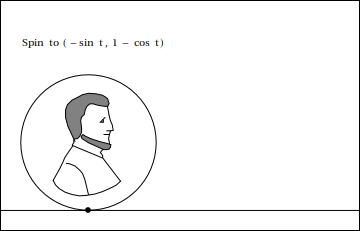How to find the parametric equation of a cycloid?
"A cycloid is the curve traced by a point on the rim of a circular wheel as the wheel rolls along a straight line." - Wikipedia

In many calculus books I have, the cycloid, in parametric form, is used in examples to find arc length of parametric equations. This is the parametric equation for the cycloid:
$$\begin{align*}x &= r(t - \sin t)\\ y &= r(1 - \cos t)\end{align*}$$
How are these equations found in the first place?
Solution 1:
$t$ measures the angle through which the wheel has rotated, starting with your point in the "down" position. Since the wheel is rolling, the distance it has rolled is the distance along the circumference of the wheel from your point to the "down" position, which (since the wheel has radius $r$) is $rt$. So the centre of the wheel, which was initially at $(0,r)$, is now at $(rt,r)$. Your point is displaced from this by $-r\sin(t)$ horizontally and $-r\cos(t)$ vertically, so it is at $(rt - r\sin(t), r - r\cos(t))$.
Solution 2:
Here is a cartoon depiction of what Robert and Ross were showing, courtesy of Stan Wagon:

Solution 3:
The center of the circle moves along a horizontal line at constant velocity. If we want the cusps to be at $y=0$, that means the center should be $(x_c,y_c)=(rt,r)$. Then we add on the location of the point on the rim relative to the center. This will be something like $(r\cos t, r\sin t)$ but we still need to get the phase right. If we start with the point on the rim at $(0,0)$ at $t=0$ the rim point is at an angle of $\frac {-\pi}2$ at $t=0$, that is, pointing straight down. A little fiddling with the phases gets the expression you quote. The scale between the center motion and rotation is set by the requirement that there be no slippage, which means the velocity of the point on the road must be $0$.
Solution 4:
This book is a great resource. See pdf page 599, actual page 567.
http://www.marystarhigh.com/apps/download/7vb7ETI4n4RtLFWDnZw0xNfQRUSB1swoBHQpP7i1l9pXZS1Y.pdf/Precalculus%20Book.pdf
You should go to the page before reading on and while reading the rest of the post.
In it, it explains everything very coherently and breaks down the derivation into 4 steps: finding an equation for the location of the center of the circle (x and y coordinates), and then finding the equation for the point P in in reference to the center.
We will start off by trying to find where the center of the circle is at angle $\theta$. The x coordinate is going to be equal to the distance traveled, which is the same thing as the length of the sector of the circle we have already covered. The sector is equal to the radius times the central angle, so the center will be at $x = a \theta$
The y coordinate of the center at any time is really easy because the center is always the height of the radius, which is $a$. Therefore, the center is at coordinates $(a\theta, a)$ at angle $\theta$.
Now, let's try and find the location of point P in reference to the center. We will start with the x coordinate.
At angle $\theta$, P will start by lagging behind, then jumping ahead, then going back to where it started. Therefore, we want to start by subtracting $0a$, then $1a$, then $0a$, then -$1a$, then going back to $0$ again. This behavior is exhibited by $a \sin \theta$, so our x coordinate is now complete: $x = a\theta - a \sin \theta = a(\theta - \sin \theta)$
Now for the y coordinate. To get the height of point P at angle $\theta$, we notice that it starts out below the center, then goes above the center, then back below. Therefore, we want to subtract $1a$, then $0a$, then $-1a$ (add $1a$), then go back to $0a$ again. The pattern of $(1, 0, -1, 0, 1)$ is exhibited by $a \cos \theta$, so we want to subtract this from the center, giving us $y = a - a \cos \theta$ , or $y = a(1 - \cos \theta)$.
Now, we are done. Our two equations are $$x = a(\theta - \sin \theta)$$ $$y = a(1 - \cos \theta)$$.